上週將一個開發完成的網站部署到 Windows Azure 網站,在部署 SQL Database 的時候原本以為還蠻簡單的,因為 SQL Server 2012 的 Management Studio 都已經把 GUI 介面寫好了,但過程中卻遇到了一些惱人的問題,因此特別撰文紀錄解決的過程。
首先我先介紹從 SQL LocalDB 資料庫遷移到雲端 SQL Database 的過程:
1. 先在 Windows Azure 建立一個新的 SQL 資料庫伺服器,並設定登入名稱與密碼
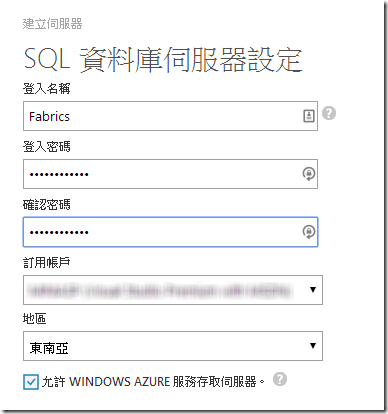
2. 設定 SQL 資料庫伺服器允許的 ip 位址,並儲存設定
3. 取得資料庫伺服器的位址
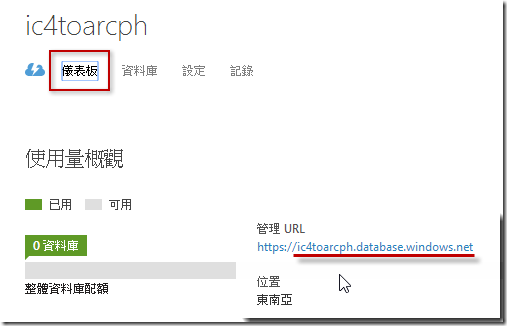
4. 開啟 Management Studio 並如下圖執行「將資料庫部署到 SQL Azure」
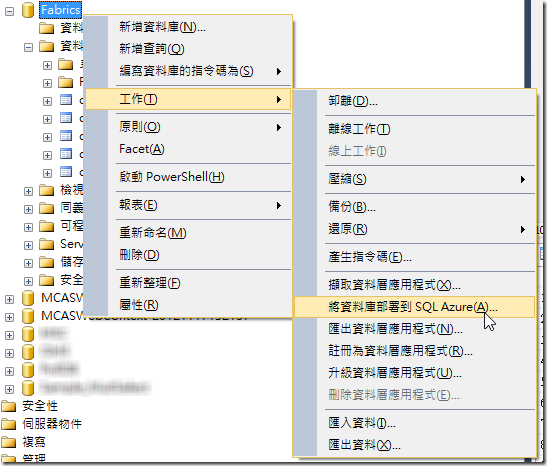
5. 設定伺服器連接,然後設定建立資料庫的相關設定 (資料庫名稱、資料庫版本與大小),然後按下一步
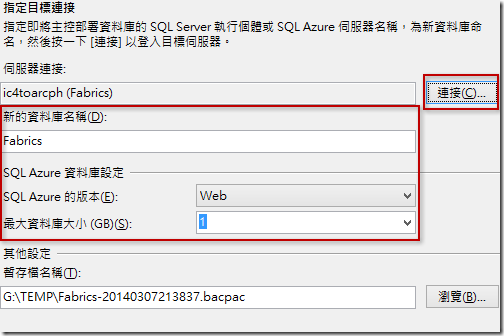
6. 確認設定後,按下 [完成] 按鈕
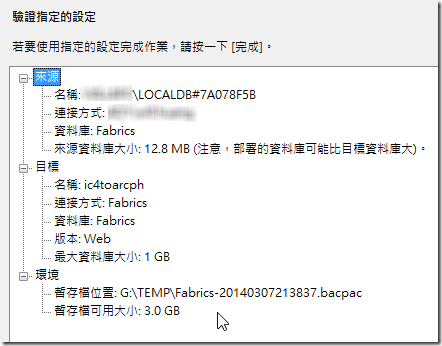
感覺就快要完成了,但此時,才是夢靨的開始!
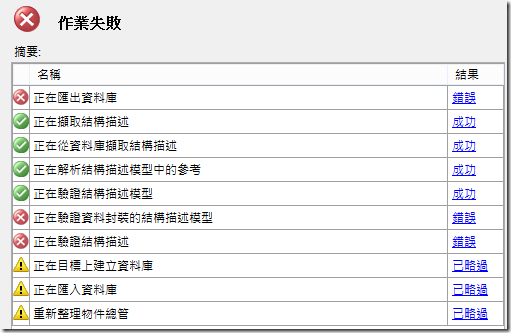
總而言之,由於雲端 SQL 資料庫的特性與本地資料庫不太一樣,有些本地資料庫才有的特性,因為在雲端 SQL 資料庫不支援,所以轉移上去時,會發生不相容的情況,會要求你先做出改變,然後才能把資料庫部署到雲端 SQL 資料庫上面。這裡我整理了三個常見的錯誤:
- 移除多餘的本地資料庫使用者 (不要讓使用者擁有任何結構描述)
- 移除 dbo.sysdiagrams 系統表格
- 移除擴充屬性 (全部都要移除)
這三點的解決方式分別說明如下:
1. 移除多餘的本地資料庫使用者
若有任何存在於本地的資料庫使用者,建議都先移除,以免無法遷移資料庫。
2. 移除 dbo.sysdiagrams 系統表格 ( 雲端 SQL 資料庫不支援資料庫圖表 )
只要執行以下 T-SQL 即可將資料庫圖表的資訊全部移除:
DROP TABLE [dbo].[sysdiagrams]
3. 移除擴充屬性 (全部都要移除) ( 雲端 SQL 資料庫不支援擴充屬性 )
由於我們經常把資料庫文件寫在資料庫的擴充屬性中,因此只要有發佈到雲端之前,都要手動把所有擴充屬性刪除才行。
刪除所有表格上的擴充屬性,可參考以下 T-SQL 指令:
select 'EXEC sp_dropextendedproperty
@name = ''MS_Description''
,@level0type = ''schema''
,@level0name = ' + object_schema_name(extended_properties.major_id) + '
,@level1type = ''table''
,@level1name = ' + object_name(extended_properties.major_id)
from sys.extended_properties
where extended_properties.class_desc = 'OBJECT_OR_COLUMN'
and extended_properties.minor_id = 0
and extended_properties.name = 'MS_Description'
刪除所有欄位上的擴充屬性,可參考以下 T-SQL 指令:
select 'EXEC sp_dropextendedproperty
@name = ''MS_Description''
,@level0type = ''schema''
,@level0name = ' + object_schema_name(extended_properties.major_id) + '
,@level1type = ''table''
,@level1name = ' + object_name(extended_properties.major_id) + '
,@level2type = ''column''
,@level2name = ' + columns.name
from sys.extended_properties
join sys.columns
on columns.object_id = extended_properties.major_id
and columns.column_id = extended_properties.minor_id
where extended_properties.class_desc = 'OBJECT_OR_COLUMN'
and extended_properties.minor_id > 0
and extended_properties.name = 'MS_Description'
事實上,還有許多資料庫物件,都可以添加擴充屬性,如果你還是無法成功將資料庫遷移上雲端 SQL 資料庫的化,你也可以透過 Query to drop all extended properties containing a certain name 這篇問題的第二份解答 ( 由 Steve Cole 提供的這份 ),透過這裡提供的指令,可以刪除大部分物件的擴充屬性,寫的還蠻完整的。以下是轉貼的副本,方便各位取用:
- /*
- This script will generate calls to sp_dropextendedproperty for every
- extended property that exists in your database.
- Actually, a caveat: I don't promise that it will catch each and every
- extended property that exists, but I'm confident it will catch most of them!
-
- It is based on this:
- http://blog.hongens.nl/2010/02/25/drop-all-extended-properties-in-a-mssql-database/
- by Angelo Hongens.
-
- Also had lots of help from this:
- http://www.sqlservercentral.com/articles/Metadata/72609/
- by Adam Aspin
-
- Adam actually provides a script at that link to do something very similar
- but when I ran it I got an error:
- Msg 468, Level 16, State 9, Line 78
- Cannot resolve the collation conflict between "Latin1_General_100_CS_AS" and "Latin1_General_CI_AS" in the equal to operation.
-
- So I put together this version instead.
-
- Use at your own risk.
-
- Jamie Thomson
- 2012-03-25
- */
- /*Are there any extended properties? Let's take a look*/
- /*
- SELECT *,
- Object_name(major_id)
- FROM sys.extended_properties xp
- */
-
- /*Now let's generate sp_dropextendedproperty statements for all of them.*/
-
- SET nocount ON;
-
- SELECT 'EXEC sp_dropextendedproperty @name = ''' + xp.name + ''' ,@level0type = ''schema'' ,@level0name = '''
- + Object_schema_name(xp.major_id)
- + ''' ,@level1type = ''table'' ,@level1name = '''
- + Object_name(xp.major_id) + ''''
- FROM sys.extended_properties xp
- JOIN sys.tables t
- ON xp.major_id = t.object_id
- WHERE xp.class_desc = 'OBJECT_OR_COLUMN'
- AND xp.minor_id = 0
- UNION
-
- SELECT 'EXEC sp_dropextendedproperty @name = ''' + sys.extended_properties.name
- + ''' ,@level0type = ''schema'' ,@level0name = '''
- + Object_schema_name(extended_properties.major_id)
- + ''' ,@level1type = ''table'' ,@level1name = '''
- + Object_name(extended_properties.major_id)
- + ''' ,@level2type = ''column'' ,@level2name = ''' + columns.name + ''''
- FROM sys.extended_properties
- JOIN sys.columns
- ON columns.object_id = extended_properties.major_id
- AND columns.column_id = extended_properties.minor_id
- WHERE extended_properties.class_desc = 'OBJECT_OR_COLUMN'
- AND extended_properties.minor_id > 0
- UNION
-
- SELECT 'EXEC sp_dropextendedproperty @name = ''' + xp.name + ''' ,@level0type = ''schema'' ,@level0name = '''
- + Object_schema_name(xp.major_id)
- + ''' ,@level1type = ''table'' ,@level1name = '''
- + Object_name(cc.parent_object_id)
- + ''' ,@level2type = ''constraint'' ,@level2name = ''' + cc.name + ''''
- FROM sys.extended_properties xp
- JOIN sys.check_constraints cc
- ON xp.major_id = cc.object_id
- UNION
-
- SELECT 'EXEC sp_dropextendedproperty @name = ''' + xp.name + ''' ,@level0type = ''schema'' ,@level0name = '''
- + Object_schema_name(xp.major_id)
- + ''' ,@level1type = ''table'' ,@level1name = '''
- + Object_name(cc.parent_object_id)
- + ''' ,@level2type = ''constraint'' ,@level2name = ''' + cc.name + ''''
- FROM sys.extended_properties xp
- JOIN sys.default_constraints cc
- ON xp.major_id = cc.object_id
- UNION
-
- SELECT 'EXEC sp_dropextendedproperty @name = ''' + xp.name + ''' ,@level0type = ''schema'' ,@level0name = '''
- + Object_schema_name(xp.major_id)
- + ''' ,@level1type = ''view'' ,@level1name = '''
- + Object_name(xp.major_id) + ''''
- FROM sys.extended_properties xp
- JOIN sys.views t
- ON xp.major_id = t.object_id
- WHERE xp.class_desc = 'OBJECT_OR_COLUMN'
- AND xp.minor_id = 0
- UNION
-
- SELECT 'EXEC sp_dropextendedproperty @name = ''' + xp.name + ''' ,@level0type = ''schema'' ,@level0name = '''
- + Object_schema_name(xp.major_id)
- + ''' ,@level1type = ''procedure'' ,@level1name = '''
- + Object_name(xp.major_id) + ''''
- FROM sys.extended_properties xp
- JOIN sys.procedures t
- ON xp.major_id = t.object_id
- WHERE xp.class_desc = 'OBJECT_OR_COLUMN'
- AND xp.minor_id = 0
- UNION
-
- SELECT 'EXEC sp_dropextendedproperty @name = ''' + xp.name + ''' ,@level0type = ''schema'' ,@level0name = '''
- + Object_schema_name(xp.major_id)
- + ''' ,@level1type = ''table'' ,@level1name = '''
- + Object_name(cc.parent_object_id)
- + ''' ,@level2type = ''constraint'' ,@level2name = ''' + cc.name + ''''
- FROM sys.extended_properties xp
- JOIN sys.foreign_keys cc
- ON xp.major_id = cc.object_id
- UNION
-
- SELECT
- 'EXEC sys.sp_dropextendedproperty @level0type = N''SCHEMA'', @level0name = ['
- + SCH.name
- + '], @level1type = ''TABLE'', @level1name = ['
- + TBL.name
- + '] , @level2type = ''CONSTRAINT'', @level2name = ['
- + SKC.name + '] ,@name = '''
- + Replace(Cast(SEP.name AS NVARCHAR(300)), '''', '''''')
- + ''''
- FROM sys.tables TBL
- INNER JOIN sys.schemas SCH
- ON TBL.schema_id = SCH.schema_id
- INNER JOIN sys.extended_properties SEP
- INNER JOIN sys.key_constraints SKC
- ON SEP.major_id = SKC.object_id
- ON TBL.object_id = SKC.parent_object_id
- WHERE SKC.type_desc = N'PRIMARY_KEY_CONSTRAINT'
- UNION
-
- SELECT
- 'EXEC sys.sp_dropextendedproperty @level0type = N''SCHEMA'', @level0name = ['
- + SCH.name
- + '], @level1type = ''TABLE'', @level1name = ['
- + TBL.name
- + '] , @level2type = ''TRIGGER'', @level2name = ['
- + TRG.name + '] ,@name = '''
- + Replace(Cast(SEP.name AS NVARCHAR(300)), '''', '''''')
- + ''''
- FROM sys.tables TBL
- INNER JOIN sys.triggers TRG
- ON TBL.object_id = TRG.parent_id
- INNER JOIN sys.extended_properties SEP
- ON TRG.object_id = SEP.major_id
- INNER JOIN sys.schemas SCH
- ON TBL.schema_id = SCH.schema_id
- UNION
-
- SELECT
- 'EXEC sys.sp_dropextendedproperty @level0type = N''SCHEMA'', @level0name = ['
- + SCH.name
- + '], @level1type = ''FUNCTION'', @level1name = ['
- + OBJ.name
- + '] , @level2type = ''PARAMETER'', @level2name = ['
- + PRM.name + '] ,@name = '''
- + Replace(Cast(SEP.name AS NVARCHAR(300)), '''', '''''')
- + ''''
- FROM sys.extended_properties SEP
- INNER JOIN sys.objects OBJ
- ON SEP.major_id = OBJ.object_id
- INNER JOIN sys.schemas SCH
- ON OBJ.schema_id = SCH.schema_id
- INNER JOIN sys.parameters PRM
- ON SEP.major_id = PRM.object_id
- AND SEP.minor_id = PRM.parameter_id
- WHERE SEP.class_desc = N'PARAMETER'
- AND OBJ.type IN ( 'FN', 'IF', 'TF' )
- UNION
-
- SELECT
- 'EXEC sys.sp_dropextendedproperty @level0type = N''SCHEMA'', @level0name = ['
- + SCH.name
- + '], @level1type = ''PROCEDURE'', @level1name = ['
- + SPR.name
- + '] , @level2type = ''PARAMETER'', @level2name = ['
- + PRM.name + '] ,@name = '''
- + Replace(Cast(SEP.name AS NVARCHAR(300)), '''', '''''')
- + ''''
- FROM sys.extended_properties SEP
- INNER JOIN sys.procedures SPR
- ON SEP.major_id = SPR.object_id
- INNER JOIN sys.schemas SCH
- ON SPR.schema_id = SCH.schema_id
- INNER JOIN sys.parameters PRM
- ON SEP.major_id = PRM.object_id
- AND SEP.minor_id = PRM.parameter_id
- WHERE SEP.class_desc = N'PARAMETER'
- UNION
-
- SELECT 'EXEC sys.sp_dropextendedproperty @name = '''
- + Replace(Cast(SEP.name AS NVARCHAR(300)), '''', '''''')
- + ''''
- FROM sys.extended_properties SEP
- WHERE class_desc = N'DATABASE'
- UNION
-
- SELECT
- 'EXEC sys.sp_dropextendedproperty @level0type = N''SCHEMA'', @level0name = ['
- + SCH.name + '] ,@name = '''
- + Replace(Cast(SEP.name AS NVARCHAR(300)), '''', '''''')
- + ''''
- FROM sys.extended_properties SEP
- INNER JOIN sys.schemas SCH
- ON SEP.major_id = SCH.schema_id
- WHERE SEP.class_desc = N'SCHEMA'
- UNION
-
- SELECT
- 'EXEC sys.sp_dropextendedproperty @level0type = N''FILEGROUP'', @level0name = ['
- + DSP.name
- + '], @level1type = ''LOGICAL FILE NAME'', @level1name = '
- + DBF.name + ' ,@name = '''
- + Replace(Cast(SEP.name AS NVARCHAR(300)), '''', '''''')
- + ''''
- FROM sys.extended_properties SEP
- INNER JOIN sys.database_files DBF
- ON SEP.major_id = DBF.file_id
- INNER JOIN sys.data_spaces DSP
- ON DBF.data_space_id = DSP.data_space_id
- WHERE SEP.class_desc = N'DATABASE_FILE'
- UNION
-
- SELECT
- 'EXEC sys.sp_dropextendedproperty @level0type = N''FILEGROUP'', @level0name = ['
- + DSP.name + '] ,@name = '''
- + Replace(Cast(SEP.name AS NVARCHAR(300)), '''', '''''')
- + ''''
- FROM sys.extended_properties SEP
- INNER JOIN sys.data_spaces DSP
- ON SEP.major_id = DSP.data_space_id
- WHERE DSP.type_desc = 'ROWS_FILEGROUP'
調整完成後,資料庫就可以順利遷移了! ^_^
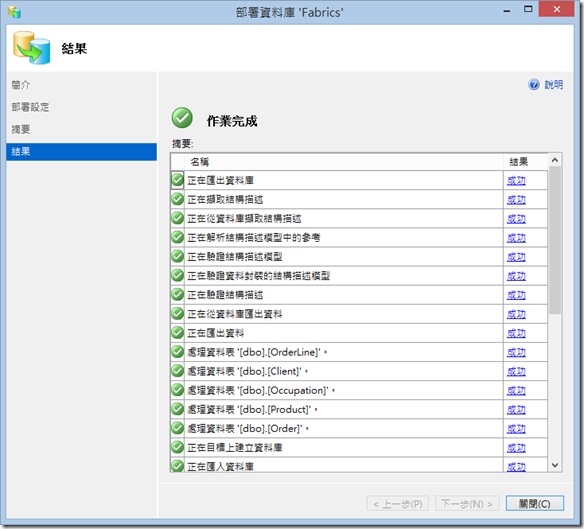
相關連結
|


 字體:小 中 大
字體:小 中 大















